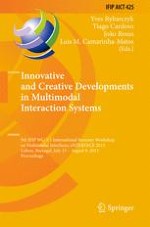2014 | Buch
Innovative and Creative Developments in Multimodal Interaction Systems
9th IFIP WG 5.5 International Summer Workshop on Multimodal Interfaces, eNTERFACE 2013, Lisbon, Portugal, July 15 – August 9, 2013. Proceedings
herausgegeben von: Yves Rybarczyk, Tiago Cardoso, João Rosas, Luis M. Camarinha-Matos
Verlag: Springer Berlin Heidelberg
Buchreihe : IFIP Advances in Information and Communication Technology
